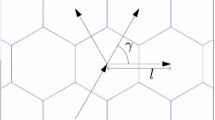Abstract
This paper presents a new approach for trajectory planning of air vehicles. It considers scenarios with risk areas and forbidden zones and takes into account the maneuverability of the air vehicle. It is flexible as to allow different kinds of objective functions such as minimizing risk, flight path length or flight time, and allows to implement constraints on fuel consumption or other resources. Additionally, it can incorporate waypoints to be passed by the air vehicle with or without specified overflight directions. The method includes planning of one-way and return trips. The underlying model is based on a discretization of the airspace into a non-regular network. Every path in the network corresponds to a flyable trajectory which means that the trajectory is within the performance limits of the air vehicle. The generation of the network is done non-deterministically. One of the main benefits of the model is that one can make use of standard network optimization techniques.
Similar content being viewed by others
References
Ahuja RK, Magnanti TL, Orlin JB (1993) Networks flows: theory, algorithms, and applications. Prentice-Hall, New York
Beasley J, Christofides N (1989) An algorithm for the resource constrained shortest path problem. Networks 19(4): 379–394
Boroujerdi A, Uhlmann J (1998) An efficient algorithm for computing least cost paths with turn constraints. Inf Process Lett 67(6): 317–321
Caldwell T (1961) On finding minimal routes in a network with turning penalties. Commun ACM 4: 107–108
Carlyle WM, Royset JO, Wood RK (2009) Routing military aircraft with a constrained shortest-path algorithm. Mil Oper Res 14(3): 31–52
Choset H, Burgard W, Hutchinson S, Kantor G, Kavraki LE, Lynch K, Thrun S (2005) Principles of robot motion: theory, algorithms, and implementation. MIT Press, Cambridge
Cormen TH, Leiserson CE, Rivest RL, Stein C (2009) Introduction to algorithms. 3rd edn. MIT Press, Cambridge
Dumitrescu I, Boland N (2003) Improved preprocessing, labeling and scaling algorithm for the weight-constrained shortest path problem. Networks 42(3): 135–153
Garey MR, Johnson DS (1979) Computers and intractability: a guide to the theory of NP-completeness. WH Freeman, San Francisco
Hassin R (1992) Approximated schemes for the restricted shortest path problem. Math Oper Res 17(1): 36–42
Helgason RV, Kennington JL, Lewis KR (2001) Cruise missile mission planning: a heuristic algorithm for automatic path generation. J Heuristics 7(5): 473–494
Hwang YK, Ahuja N (1992) Gross motion planning—a survey. ACM Comput Surv 24(3): 219–291
Kim J, Hespanha JP (2003) Discrete approximations to continuous shortest-path: application to minimum-risk path planning for groups of UAVs. 42nd IEEE Conf Decis Control 2: 1734–1740
Kuipers FA, Korkmaz T, Krunz M, Van Mieghem P (2004) Performance evaluation of constraint-based path selection algorithms. IEEE Netw 18(5): 16–23
Latombe JC (1991) Robot motion planning. Kluwer Academic Publishers, Boston
Laumond JP (1998) Robot motion planning and control. LN control inf sci 229. Springer, New York
LaValle SM (2006) Planning algorithms. Cambridge University Press, Cambridge
Lorenz DH, Raz D (2001) A simple efficient approximation scheme for the restricted shortest path problem. Oper Res Lett 28(5): 213–219
Masehian E, Sedighizadeh D (2007) Classic and heuristic approaches in robot motion planning—a chronological review. World Acad Sci Eng Technol 29: 101–106
Pfeiffer B, Batta R, Klamroth K, Nagi R (2005) Path planning for UAVs in the presence of threat zones using probabilistic modeling. Institute of Applied Mathematics, University of Erlangen, Erlangen
Soliman H, Peyton C (2002) An efficient routing algorithm for all-optical networks with turn constraints. In: Proceedings of the 10th IEEE international symposium on modeling, analysis and simulation of computer and telecommunication systems, pp 161–166
Wattleworth JA, Shuldiner PW (1963) Analytical methods in transportation: left-turn penalties in traffic assignment models. J Eng Mech 89: 97–126
Zabarankin M, Uryasev S, Pardalos P (2001) Optimal risk path algorithms. In: Murphey R, Pardalos P (eds) Cooperative control and optimization. Kluwer, Dordrecht, pp 271–303
Zabarankin M, Uryasev S, Murphey R (2006) Aircraft routing under the risk of detection. Nav Res Logist 53(8): 728–747
Author information
Authors and Affiliations
Corresponding author
Rights and permissions
About this article
Cite this article
Babel, L. Trajectory planning for unmanned aerial vehicles: a network optimization approach. Math Meth Oper Res 74, 343–360 (2011). https://doi.org/10.1007/s00186-011-0366-1
Received:
Accepted:
Published:
Issue Date:
DOI: https://doi.org/10.1007/s00186-011-0366-1




